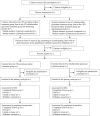A pragmatic randomized trial evaluating pre-operative aqueous antiseptic skin solutions in open fractures (Aqueous-PREP): statistical analysis plan
- PMID: 36096826
- PMCID: PMC9465853
- DOI: 10.1186/s13063-022-06541-0
A pragmatic randomized trial evaluating pre-operative aqueous antiseptic skin solutions in open fractures (Aqueous-PREP): statistical analysis plan
Abstract
Background: Approximately 1 in 10 patients with a surgically treated open fracture will develop a surgical site infection. The Aqueous-PREP trial will investigate the effect of 10% povidone-iodine versus 4% chlorhexidine in aqueous antiseptic solutions in reducing infections after open fracture surgery. The study protocol was published in April 2020.
Methods and design: The Aqueous-PREP trial is a pragmatic, multicenter, open-label, randomized multiple period cluster crossover trial. Each participating cluster is randomly assigned in a 1:1 ratio to provide 1 of the 2 study interventions on all eligible patients during a study period. The intervention periods are 2 months in length. After completing a 2-month period, the participating cluster crosses over to the alternative intervention. We plan to enroll a minimum of 1540 patients at 14 sites.
Results: The primary outcome is surgical site infection guided by the Centers for Disease Control and Prevention's National Healthcare Safety Network reporting criteria (2017). All participants' surgical site infection surveillance period will end 30 days after definitive fracture management surgery for superficial infections and 90 days after definitive fracture management surgery for deep incisional or organ/space infections [1]. The secondary outcome is an unplanned fracture-related reoperation within 12 months of the fracture.
Conclusion: This manuscript serves as the formal statistical analysis plan (version 1.0) for the Aqueous-PREP trial. The statistical analysis plan was completed on February 28, 2022.
Keywords: Aqueous antiseptic solutions; Open fracture; Surgical site infection.
© 2022. The Author(s).
Conflict of interest statement
Dr. Slobogean reports editorial or governing board for the Journal of Orthopedic Trauma, board or committee member for the Orthopedic Trauma Association, paid consultant for Smith & Nephew, and paid consultant for Zimmer, all outside the submitted work. Dr. Sprague reports board or committee member for Orthopedic Trauma Association, employment from Global Research Solutions Inc. and consultant fees from the University of Sherbrooke and Platform Life Sciences, all outside the submitted work. Dr. Bhandari reports paid consultant from AgNovos Healthcare, research support from the Canadian Institutes of Health Research (CIHR), board or committee member for the International Society of Orthopedic Surgery and Traumatology (SICOT), research support from the National Institutes of Health (NIAMS & NICHD), research support from Physicians’ Services Incorporated, paid consultant for Sanofi-Aventis, paid consultant for Smith & Nephew, and research support from the US Department of Defense, all outside the submitted work. Dr. O’Hara reports stock or stock options from Arbutus Medical Inc., all outside the submitted work. The other authors declare no competing interests.
References
-
- Centers for Disease Control and Prevention (CDC). Surgical Site Infection (SSI) Event; 2017.
Publication types
MeSH terms
Substances
Grants and funding
LinkOut - more resources
Full Text Sources
Medical
Miscellaneous


